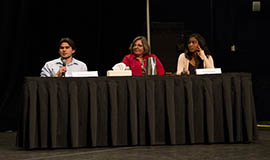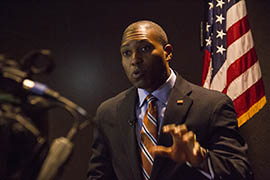Cronkite News has moved to a new home at cronkitenews.azpbs.org. Use this site to search archives from 2011 to May 2015. You can search the new site for current stories.
Federal panel visits Arizona to discuss violence against reservation children
SALT RIVER PIMA-MARICOPA INDIAN COMMUNITY – Daniel Cauffman, 21, can speak candidly about the physical abuse he suffered at the hands of his stepmother when he was a child.
He knows his story of closed-fist punches coupled with other acts of physical violence speaks for hundreds – if not thousands – of children on Native American lands across the country.
“I hope it does help,” said Cauffman, a member of the Pokagon Band of Potawatomi, Mich.
He was one of several young people to give testimony Tuesday alongside regional experts at a public hearing for the advisory committee to the Attorney General’s Task Force on American Indian and Alaska Native Children Exposed to Violence.
“I’m glad they do stuff like this ’cause it does raise awareness,” Cauffman said. “As far as hopes goes, hopefully we can pull kids out of the situation.”
About 75 people attended the all-day hearing at Talking Stick Resort near Scottsdale. It was the second of four across the country to secure testimony and information so the task force can generate policy recommendations for Attorney General Eric Holder.
In December, the committee was in Bismarck, N.D. The final two hearings will be in Fort Lauderdale, Fla. and Anchorage, Alaska.
The committee is one arm of the Justice Department’s renewed efforts to combat violence and crime on reservations. The department also has a federal working group with multiple agencies to make immediate on-the-ground improvements.
The 13-member committee, chaired by former North Dakota Sen. Byron Dorgan and Joanne Shenandoah, an Iroquois, will issue policy and legislative recommendations this fall based on its findings.
Associate Attorney General Tony West said the committee was established last year to specifically address the difficulties native communities faced because of their exposure to violence.
“Let’s be clear: Exposure to violence by children in this country is a problem all over this country. We know that more than 60 percent of kids regardless of race, regardless of ethnicity, they are exposed to some sort of violence, either as witnesses or as victims and that can have significant traumatic effects,” West said. “But what we also know is that when we look at Indian Country, what we see are challenges that are exacerbated.”
West cited higher rates of assault, crime and trauma among this population.
“When you look at Indian youth and you look at the fact that second leading cause of death for native children aged 15-34 is suicide … when you couple that with the unique historical trauma native children have faced … those are unique challenges that native communities and generations of the first Americans, in particular children, face,” he said.
Another speaker, Temetria Young, 18, a member of the San Carlos Apache Tribe, discussed her time in and out of juvenile facilities, a time period she measures as covering three birthdays.
Young earned her GED while in juvenile custody and said she wishes there had been more people to talk to, both before and after her incarceration. She said young people in her situation need access to adults and educators who show they care.
“I really liked the graduation ceremony. I never expected anything like it,” she said. “I felt important and it made me want to do something with myself.”








